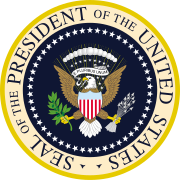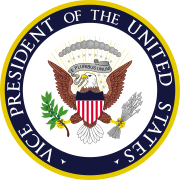Post by Wandering Mind on Sept 19, 2018 18:20:39 GMT
Per Wikipedia -
See also: Article Two of the United States Constitution and List of United States federal executive orders
The executive power in the federal government is vested in the President of the United States,[7] although power is often delegated to the Cabinet members and other officials.[8][9] The president and vice president are elected as running mates by the Electoral College, for which each state, as well as the District of Columbia, is allocated a number of seats based on its representation (or ostensible representation, in the case of D.C.) in both houses of Congress.[7][10] The president is limited to a maximum of two four-year terms.[11] If the president has already served two years or more of a term to which some other person was elected, he or she may only serve one more additional four-year term.[7]
President
Main article: President of the United States
Seal of the President of the United States

The executive branch consists of the president and those to whom the president's powers are delegated. The president is both the head of state and government, as well as the military commander-in-chief and chief diplomat. The president, according to the Constitution, must "take care that the laws be faithfully executed", and "preserve, protect and defend the Constitution". The president presides over the executive branch of the federal government, an organization numbering about 5 million people, including 1 million active-duty military personnel and 600,000 postal service employees.
The president may sign legislation passed by Congress into law or may veto it, preventing it from becoming law unless two-thirds of both houses of Congress vote to override the veto. The president may unilaterally sign treaties with foreign nations. However, ratification of international treaties requires a two-thirds majority vote in the Senate. The president may be impeached by a majority in the House and removed from office by a two-thirds majority in the Senate for "treason, bribery, or other high crimes and misdemeanors". The president may not dissolve Congress or call special elections but does have the power to pardon or release criminals convicted of offenses against the federal government (except in cases of impeachment), enact executive orders, and (with the consent of the Senate) appoint Supreme Court justices and federal judges.
Vice president
Main article: Vice President of the United States
Seal of the Vice President of the United States

The vice president is the second-highest official in rank of the federal government. The office of the vice president's duties and powers are established in the legislative branch of the federal government under Article 1, Section 3, Clauses 4 and 5 as the President of the Senate; this means that he or she is the designated presiding officer of the Senate. In that capacity, the vice president has the authority (ex officio, for they are not an elected member of the Senate) to cast a tie-breaking vote. Pursuant to the Twelfth Amendment, the vice president presides over the joint session of Congress when it convenes to count the vote of the Electoral College. As first in the U.S. presidential line of succession, the vice president's duties and powers move to the executive branch when becoming president upon the death, resignation, or removal of the president, which has happened nine times in U.S. history. Lastly, in the case of a Twenty-fifth Amendment succession event, the vice president would become acting president, assuming all of the powers and duties of president, except being designated as president. Accordingly, by circumstances, the Constitution designates the vice president as routinely in the legislative branch, or succeeding to the executive branch as president, or possibly being in both as acting president pursuant to the Twenty-fifth Amendment. Because of circumstances, the overlapping nature of the duties and powers attributed to the office, the title of the office and other matters, such has generated a spirited scholarly dispute regarding attaching an exclusive branch designation to the office of vice president.[12][13]
Cabinet, executive departments, and agencies
Main articles: Cabinet of the United States, United States federal executive departments, and List of federal agencies in the United States
The day-to-day enforcement and administration of federal laws is in the hands of the various federal executive departments, created by Congress to deal with specific areas of national and international affairs. The heads of the 15 departments, chosen by the president and approved with the "advice and consent" of the U.S. Senate, form a council of advisers generally known as the president's "Cabinet". Once confirmed, these "cabinet officers" serve at the pleasure of the president. In addition to departments, a number of staff organizations are grouped into the Executive Office of the President. These include the White House staff, the National Security Council, the Office of Management and Budget, the Council of Economic Advisers, the Council on Environmental Quality, the Office of the U.S. Trade Representative, the Office of National Drug Control Policy, and the Office of Science and Technology Policy. The employees in these United States government agencies are called federal civil servants.
There are also independent agencies such as the United States Postal Service (USPS), the National Aeronautics and Space Administration (NASA), the Central Intelligence Agency (CIA), the Environmental Protection Agency (EPA), and the United States Agency for International Development (USAID). In addition, there are government-owned corporations such as the Federal Deposit Insurance Corporation and the National Railroad Passenger Corporation.
The executive power in the federal government is vested in the President of the United States,[7] although power is often delegated to the Cabinet members and other officials.[8][9] The president and vice president are elected as running mates by the Electoral College, for which each state, as well as the District of Columbia, is allocated a number of seats based on its representation (or ostensible representation, in the case of D.C.) in both houses of Congress.[7][10] The president is limited to a maximum of two four-year terms.[11] If the president has already served two years or more of a term to which some other person was elected, he or she may only serve one more additional four-year term.[7]
President
Main article: President of the United States
Seal of the President of the United States

The executive branch consists of the president and those to whom the president's powers are delegated. The president is both the head of state and government, as well as the military commander-in-chief and chief diplomat. The president, according to the Constitution, must "take care that the laws be faithfully executed", and "preserve, protect and defend the Constitution". The president presides over the executive branch of the federal government, an organization numbering about 5 million people, including 1 million active-duty military personnel and 600,000 postal service employees.
The president may sign legislation passed by Congress into law or may veto it, preventing it from becoming law unless two-thirds of both houses of Congress vote to override the veto. The president may unilaterally sign treaties with foreign nations. However, ratification of international treaties requires a two-thirds majority vote in the Senate. The president may be impeached by a majority in the House and removed from office by a two-thirds majority in the Senate for "treason, bribery, or other high crimes and misdemeanors". The president may not dissolve Congress or call special elections but does have the power to pardon or release criminals convicted of offenses against the federal government (except in cases of impeachment), enact executive orders, and (with the consent of the Senate) appoint Supreme Court justices and federal judges.
Vice president
Main article: Vice President of the United States
Seal of the Vice President of the United States

The vice president is the second-highest official in rank of the federal government. The office of the vice president's duties and powers are established in the legislative branch of the federal government under Article 1, Section 3, Clauses 4 and 5 as the President of the Senate; this means that he or she is the designated presiding officer of the Senate. In that capacity, the vice president has the authority (ex officio, for they are not an elected member of the Senate) to cast a tie-breaking vote. Pursuant to the Twelfth Amendment, the vice president presides over the joint session of Congress when it convenes to count the vote of the Electoral College. As first in the U.S. presidential line of succession, the vice president's duties and powers move to the executive branch when becoming president upon the death, resignation, or removal of the president, which has happened nine times in U.S. history. Lastly, in the case of a Twenty-fifth Amendment succession event, the vice president would become acting president, assuming all of the powers and duties of president, except being designated as president. Accordingly, by circumstances, the Constitution designates the vice president as routinely in the legislative branch, or succeeding to the executive branch as president, or possibly being in both as acting president pursuant to the Twenty-fifth Amendment. Because of circumstances, the overlapping nature of the duties and powers attributed to the office, the title of the office and other matters, such has generated a spirited scholarly dispute regarding attaching an exclusive branch designation to the office of vice president.[12][13]
Cabinet, executive departments, and agencies
Main articles: Cabinet of the United States, United States federal executive departments, and List of federal agencies in the United States
The day-to-day enforcement and administration of federal laws is in the hands of the various federal executive departments, created by Congress to deal with specific areas of national and international affairs. The heads of the 15 departments, chosen by the president and approved with the "advice and consent" of the U.S. Senate, form a council of advisers generally known as the president's "Cabinet". Once confirmed, these "cabinet officers" serve at the pleasure of the president. In addition to departments, a number of staff organizations are grouped into the Executive Office of the President. These include the White House staff, the National Security Council, the Office of Management and Budget, the Council of Economic Advisers, the Council on Environmental Quality, the Office of the U.S. Trade Representative, the Office of National Drug Control Policy, and the Office of Science and Technology Policy. The employees in these United States government agencies are called federal civil servants.
There are also independent agencies such as the United States Postal Service (USPS), the National Aeronautics and Space Administration (NASA), the Central Intelligence Agency (CIA), the Environmental Protection Agency (EPA), and the United States Agency for International Development (USAID). In addition, there are government-owned corporations such as the Federal Deposit Insurance Corporation and the National Railroad Passenger Corporation.
